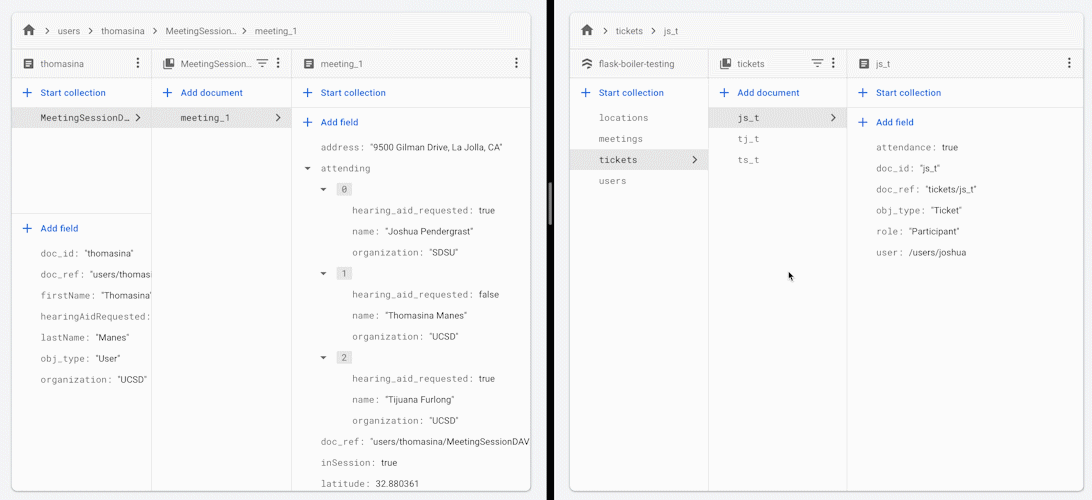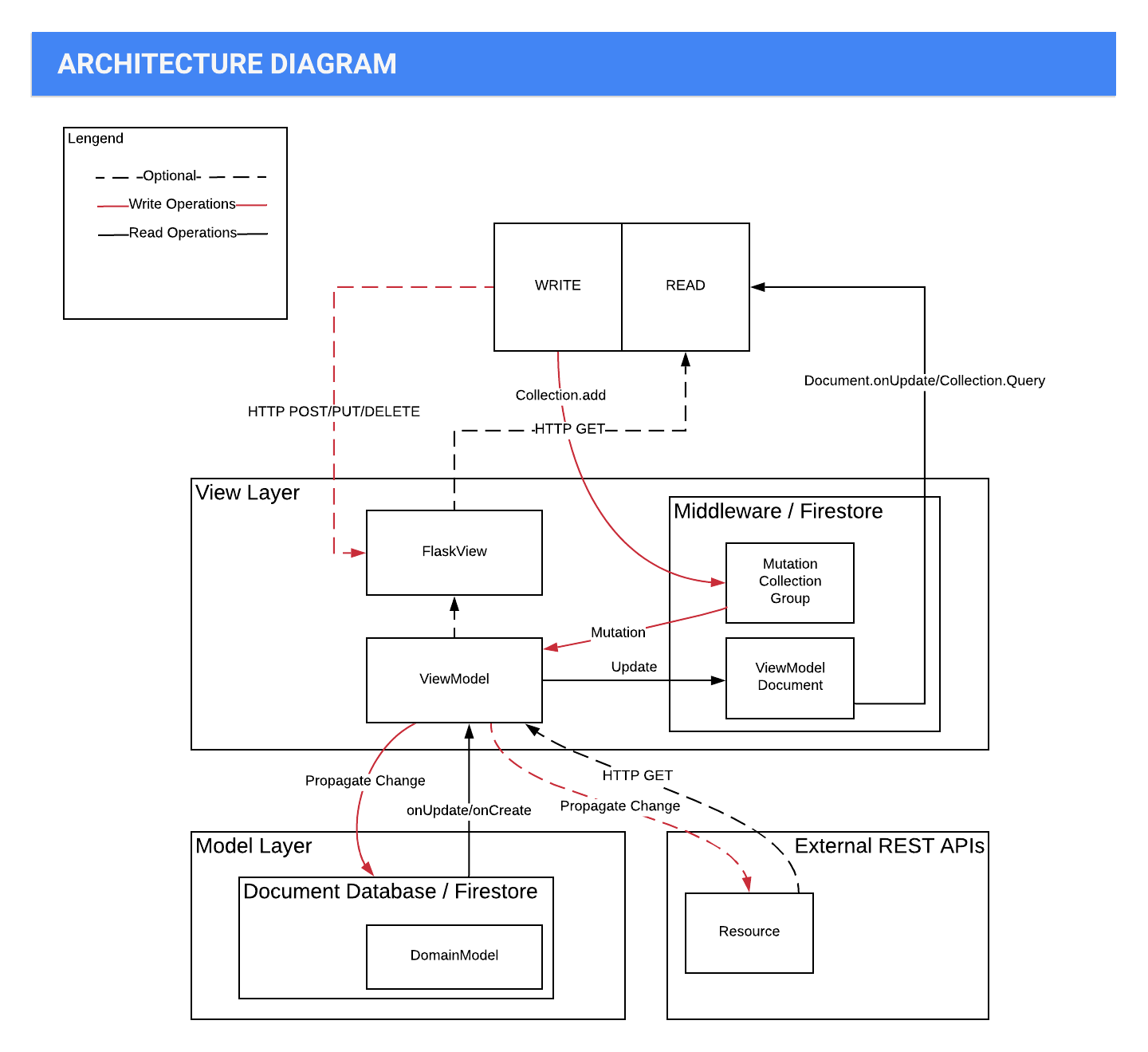Build flask project with Firebase
Project description
flask-boiler
"boiler": Backend-Originated Instantly-Loaded Entity Repository
Flask-boiler manages your application state with Firestore. You can create view models that aggregates underlying data sources and store them immediately and permanently in Firestore. As a result, your front end development will be as easy as using Firestore.
Demo:
When you change the attendance status of one of the participants in the meeting, all other participants receive an updated version of the list of people attending the meeting.
Some reasons that you may want to use this framework:
- The automatically documented API accelerates your development
- You want to use Firestore to build your front end, but you have to give up because your data contains many relational reference
- You want to move some business logic to back end
- You are open to trying something new and contributing to a framework
- You want to develop a new reactive service to your existing flask app
This framework is at beta testing stage. API is not guaranteed and may change.
Documentations: readthedocs
Quickstart: Quickstart
API Documentations: API Docs
Example of a Project using flask-boiler: gravitate-backend
Installation
In your project's requirements.txt,
# Append to requirements, unless repeating existing requirements
google-cloud-firestore
flask-boiler # Not released to pypi yet
Configure virtual environment
pip install virtualenv
virtualenv env
source env/bin/activate
In your project directory,
pip install -r requirements.txt
See more in Quickstart.
State Management
You can combine information gathered in domain models and serve them in Firestore, so that front end can read all data required from a single document or collection, without client-side queries and excessive server roundtrip time.
There is a medium article that explains a similar architecture called "reSolve" architecture.
See examples/meeting_room/view_models on how to use flask-boiler
to expose a "view model" in firestore that can be queried directly
by front end without aggregation.
Save data
def CityBase(DomainModel):
_collection_name = "cities"
class City(CityBase):
_schema_cls = CitySchema
City.new(
doc_id='SF',
name='San Francisco',
state='CA',
country='USA',
capital=False,
populations=860000,
regions=['west_coast', 'norcal']).save()
# ...
Relationship
Flask-boiler adds an option to retrieve a relation with minimal steps. Take an example given from SQLAlchemy,
category_id = utils.random_id()
py = Category.new(doc_id=category_id)
py.name = "Python"
post_id = utils.random_id()
p = Post.new(doc_id=post_id)
p.title = "snakes"
p.body = "Ssssssss"
# py.posts.append(p)
p.category = py
p.save()
See examples/relationship_example.py
Context Management
In __init__ of your project source root:
import os
from flask_boiler import context
from flask_boiler import config
Config = config.Config
testing_config = Config(app_name="your_app_name",
debug=True,
testing=True,
certificate_path=os.path.curdir + "/../your_project/config_jsons/your_certificate.json")
CTX = context.Context
CTX.read(testing_config)
Note that initializing Config with certificate_path is unstable and
may be changed later.
In your project code,
from flask_boiler import context
CTX = context.Context
# Retrieves firestore database instance
CTX.db
# Retrieves firebase app instance
CTX.firebase_app
Automatically Generated Swagger Docs
You can enable auto-generated swagger docs. See: examples/view_example.py
Create Flask View
You can create a flask view to specify how a view model is read and changed.
app = Flask(__name__)
meeting_session_mediator = view_mediator.ViewMediator(
view_model_cls=MeetingSession,
app=app,
mutation_cls=MeetingSessionMutation
)
meeting_session_mediator.add_list_get(
rule="/meeting_sessions",
list_get_view=meeting_session_ops.ListGet
)
meeting_session_mediator.add_instance_get(
rule="/meeting_sessions/<string:doc_id>")
meeting_session_mediator.add_instance_patch(
rule="/meeting_sessions/<string:doc_id>")
user_mediator = view_mediator.ViewMediator(
view_model_cls=UserView,
app=app,
)
user_mediator.add_instance_get(
rule="/users/<string:doc_id>"
)
swagger = Swagger(app)
app.run(debug=True)
Object Lifecycle
Once
Object created with cls.new ->
Object exported with obj.to_view_dict.
Multi
Object created when a new domain model is created in database ->
Object changed when underlying datasource changes ->
Object calls self.notify
Advantages
Decoupled Domain Model and View Model
Using Firebase Firestore sometimes require duplicated fields across several documents in order to both query the data and display them properly in front end. Flask-boiler solves this problem by decoupling domain model and view model. View model are generated and refreshed automatically as domain model changes. This means that you will only have to write business logics on the domain model without worrying about how the data will be displayed. This also means that the View Models can be displayed directly in front end, while supporting real-time features of Firebase Firestore.
One-step Configuration
Rather than configuring the network and different certificate settings for your database and other cloud services. All you have to do is to enable related services on Google Cloud Console, and add your certificate. Flask-boiler configures all the services you need, and expose them as a singleton Context object across the project.
Redundancy
Since all View Models are persisted in Firebase Firestore. Even if your App Instance is offline, the users can still access a view of the data from Firebase Firestore. Every View is also a Flask View, so you can also access the data with auto-generated REST API, in case Firebase Firestore is not viable.
Added Safety
By separating business data from documents that are accessible to the front end, you have more control over which data is displayed depending on the user's role.
One-step Documentation
All ViewModels have automatically generated documentations (provided by Flasgger). This helps AGILE teams keep their documentations and actual code in sync.
Fully-extendable
When you need better performance or relational database
support, you can always refactor a specific layer by
adding modules such as flask-sqlalchemy.
Comparisons
GraphQL
In GraphQL, the fields are evaluated with each query, but flask-boiler evaluates the fields if and only if the underlying data source changes. This leads to faster read for data that has not changed for a while. Also, the data source is expected to be consistent, as the field evaluation are triggered after all changes made in one transaction to firestore is read.
GraphQL, however, lets front-end customize the return. You must define the exact structure you want to return in flask-boiler. This nevertheless has its advantage as most documentations of the request and response can be done the same way as REST API.
REST API / Flask
REST API does not cache or store the response. When a view model is evaluated by flask-boiler, the response is stored in firestore forever until update or manual removal.
Flask-boiler controls role-based access with security rules integrated with Firestore. REST API usually controls these access with a JWT token.
Redux
Redux is implemented mostly in front end. Flask-boiler targets back end and is more scalable, since all data are communicated with Firestore, a infinitely scalable NoSQL datastore.
Flask-boiler is declarative, and Redux is imperative. The design pattern of REDUX requires you to write functional programming in domain models, but flask-boiler favors a different approach: ViewModel reads and calculates data from domain models and exposes the attribute as a property getter. (When writing to DomainModel, the view model changes domain model and exposes the operation as a property setter). Nevertheless, you can still add function callbacks that are triggered after a domain model is updated, but this may introduce concurrency issues and is not perfectly supported due to the design tradeoff in flask-boiler.
Architecture Diagram:
Contributing
Pull requests are welcome.
Please make sure to update tests as appropriate.
License
Project details
Release history Release notifications | RSS feed
Download files
Download the file for your platform. If you're not sure which to choose, learn more about installing packages.
















